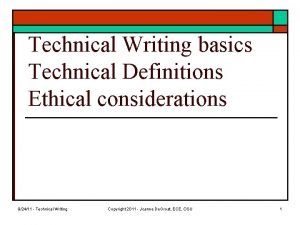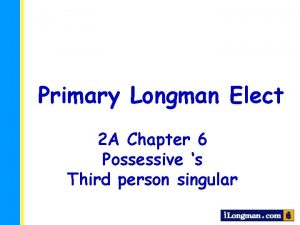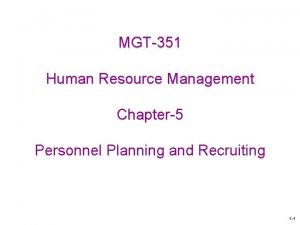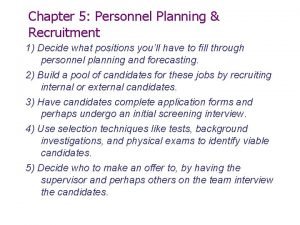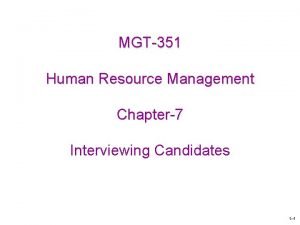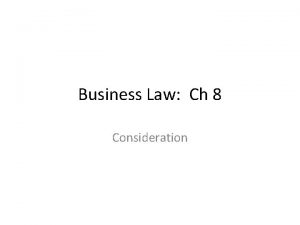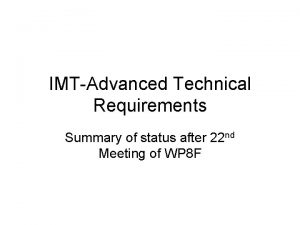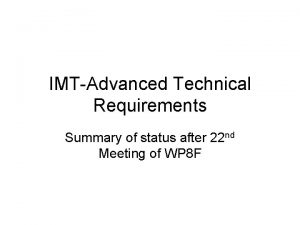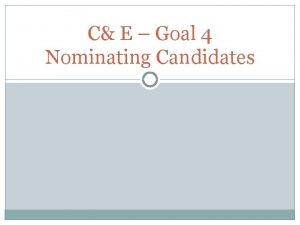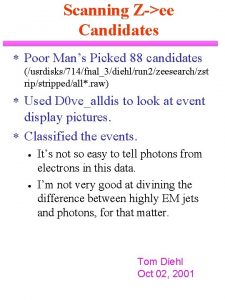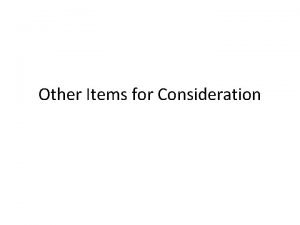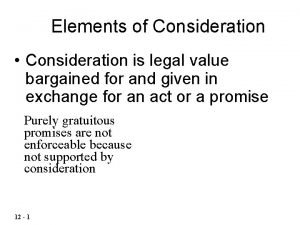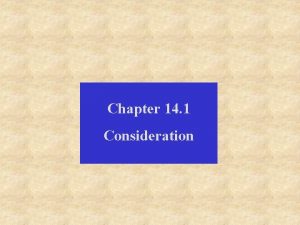REV080019 Consideration on Technical Candidates for IMTAdvanced 3


















- Slides: 18

REV-080019 Consideration on Technical Candidates for IMT-Advanced 3 GPP RAN IMT-advanced Workshop Date: April 7 th~8 th, 2008 Agenda Item: 3 Source: LG Electronics, Inc.

Outline ◙ Overview of Target Features in IMT-advanced ◙ Approach toward LTE-advanced from 3 GPP LTE ◙ Technical View for Enabling Technologies and System Design of LTE-advanced § Multi-hop relaying § Bandwidth Assignment § Enhanced MIMO § LTE technical items to be enhanced Great Company Great People 2

Main Features in IMT-advanced ◙ Service Perspective § § § High quality mobile services Enhanced peak data rate to support advanced services and application Worldwide roaming capability Compatibility of services within IMT and with fixed networks Capability of interworking with other radio access systems ◙ Implementation Perspective § A high degree of commonality of functionality worldwide while retaining the § § flexibility to support a wide range of services and applications in a cost efficient manner User-friendly applications, services and equipment User equipment suitable for worldwide use Source: Attachment 7. 1 to Document 5 D/97 Great Company Great People 3

Provisional View for IMT-advanced Requirement in ITU-R WP 5 D Deployment environment Requirement Parameters Indoor Microcellular Base Coverage Urban High Speed 3 2. 6 2. 1 1 2. 5/1. 5 2/1. 3 1. 7/1. 2 0. 7/0. 6 Cell Spectral Efficiency (bps/Hz/cell) DL (4 x 2) Peak Spectral Efficiency (bps/Hz/cell) DL (4 x 4/4 x 2) 10/7 UL (2 x 4/1 x 4) 5/2. 5 UL (2 x 4/1 x 4) Bandwidth (MHz) Cell Edge Throughput (bps/Hz) 20 or 40 DL 0. 1 0. 075 0. 08 0. 05 UL 0. 08 0. 05 0. 03 0. 02 C-plane 100 U-plane 10 Latency (ms) Handover Latency (ms) Mobility class Intra-freq. [25/30] Inter-freq. N/A Inter-sys. N/A Stationary Pedestrian Vehicular High Speed Source: ITU-R WP 5 D IMT. TECH document, Feb. ’ 08. Great Company Great People 4

Overall Company Views on 3 GPP RAN Specification of IMTadvanced ◙ Evolutionary Approach from 3 GPP LTE Specification § Very close potential of 3 GPP LTE with target requirements of IMT-advanced § Fast and efficient correspondence against the timeline of WP 5 D’s specification and commercialization for IMT-advanced ◙ Careful Verification for Various Emerging Technology Candidates § Feasibility at the commercial implementation time § Accurate clarification for the trade-off between benefits and overhead/complexity ◙ Efficient System Design for a New Value-added Service Creation § Provisioning a technical background for development of killer applications in IMT-advanced Great Company Great People 5

System Comparison between 3 GPP LTE and IMT-advanced (1/2) ◙ Peak Spectral Efficiency System 3 GPP LTE IMT-advanced DL 16. 32 (4 x 4) / 8. 64 (2 x 2) 10 (4 x 4) / 7 (4 x 2) UL 4. 32 (64 QAM, 1 x 2) / 2. 88 (16 QAM, 1 x 2) 5 (2 x 4) / 2. 5 (1 x 2) Requirement Parameters Peak Spectral Efficiency (bps/Hz/cell) § Almost equal or better peak data rate potential of E-UTRAN compared with the related requirements of IMT-advanced ◙ Cell Spectral Efficiency System Requirement Parameters Cell Spectral Efficiency (bps/Hz/cell) 3 GPP LTE IMT-advanced ISD = 500 m ISD = 1732 m Microcellular Base Coverage Urban DL 2. 67 (4 x 4)/1. 87 (4 x 2) 2. 41 (4 x 4)/1. 85 (4 x 2) 2. 6 (4 x 2) 2. 1 (4 x 2) UL 0. 776 (2 x 2) /0. 735(1 x 2) /1. 103 (1 x 4) 0. 681(1 x 2) /1. 038 (1 x 4) 2 (2 x 4)/1. 3 (1 x 4) 1. 7 (2 x 4)/1. 2 (1 x 4) § Higher cell spectral efficiency requirement of IMT-advanced than performance of E-UTRAN in both uplink and downlink Source: • ITU-R WP 5 D IMT. TECH document, Feb. ’ 08 • 3 GPP RAN 1 R 1 -072580, May ’ 07 Great Company Great People 6

System Comparison between 3 GPP LTE and IMT-advanced (2/2) ◙ Cell Edge User Throughput System Requirement Parameters DL Cell Edge User Throughput (bps/Hz/user) UL (2 x 4/1 x 2) 3 GPP LTE IMT-advanced ISD = 500 m ISD = 1732 m Microcellular Base Coverage Urban 0. 08 (4 x 4)/0. 06 (4 x 2) 0. 08 (4 x 4)/0. 05 (4 x 2) 0. 075 (4 x 2) 0. 06 (4 x 2) 0. 01 (2 x 2) /0. 024(1 x 2) /0. 052 (1 x 4) 0. 0044(1 x 2) /0. 0094 (1 x 4) 0. 05 (1 x 4) 0. 03 (1 x 4) § Higher cell edge throughput requirement of IMT-advanced than performance of E-UTRAN in both uplink and downlink ◙ Latency System 3 GPP LTE IMT-advanced C-plane 100 U-plane 5 10 Requirement Parameters Latency (ms) § Equal or better requirement of E-UTRAN than that of IMT-advanced including handover latency Source: • ITU-R WP 5 D IMT. TECH document, Feb. ’ 08 • 3 GPP RAN 1 R 1 -072580, May ’ 07 • 3 GPP TS 25. 912 Great Company Great People 7

Main Enhancement Factors of 3 GPP LTE for Evolving toward LTE-advanced ◙ Quantitative Enhancement Factors § Uplink and downlink cell spectral efficiency § Uplink and downlink cell edge user throughput § Peak data rate and system latency • Under the condition of a 3 GPP’s decision regarding the superiority of a 3 GPP LTE-advanced to IMT-advanced requirement ◙ Non-quantitative Enhancement Factors § § Network scalability System inter-operability Enhanced mobility support Etc. Great Company Great People 8

Multi-hop Relaying (1/2) UE Peer-to-Peer Tx/Rx Conventional UE-e. Node. B Tx/Rx • Direct inter-UE connectivity • Autonomous ad-hoc network configuration and management • Conventional single-hop Tx/Rx between UE and e. Node. B as a basic connection scheme Wireless link connection e. Node. B Relay Node Tx/Rx • Remote relay node Tx/Rx • L 1 baseband processing and RRM • Coverage extension and throughput enhancement Great Company Great People 9

Multi-hop Relaying (2/2) ◙ Expected Trade-off Benefits • Coverage extension • Throughput/capacity improvement • New killer application/service Drawbacks vs. • System complication • Enlarged control/signaling overhead • Large change factors from the current 3 GPP LTE spec ◙ Consideration Points § Things to be further investigated • Verification for practical benefits against system overhand & complexity • Smooth migration toward multi-hop relaying in addition to single-hop UE-e. NB transmission & reception § Early-stage features of multi-hop relaying • Max. 2 hop relaying, i. e. single relay node between UE and e. Node. B • Minimized impact on UE spec. • No support of UE peer-to-peer ad hoc transmission & reception Great Company Great People 10

Bandwidth Assignment ◙ Consideration Points § Backward compatible co-existence with LTE and LTE-advanced in IMT carrier bands • SI or WI creation in 3 GPP RAN for most carrier BW candidates given by WRC’ 07 • Support of smooth migration from LTE toward LTE-advanced § Support of wider system bandwidth in LTE-advanced for higher data rate transmission • Issue of the system BW of 20 or 40 MHz on the system requirement documentation of IMT-advanced in ITU-R WP 5 D • Probable situation of using a more extended system BW for higher data rate support ◙ Technical check points on implementation feasibility § Potential of commercial-level RF filter • Effective bandwidth range § Potential of commercial-level ADC • Sampling rate and quantization resolution § Decoding complexity • Channel decoding speed and required soft buffer size Great Company Great People 11

Backward Compatible Co-existence of LTE and LTEadvanced ◙ Smooth Migration toward LTE-advanced on LTE Carriers Freq LTE Carrier LTE LTE-advanced Time FDM-based allocation concept TDM-based allocation concept • Improved uplink cell-edge performance and/or coverage extension • Flexibility restriction in new system design • More guard band overhead and limited bandwidth utilization • Full transparency for UE Tx/Rx operation • Full bandwidth utilization • Large flexibility in new system design • Relatively weak power utilization on uplink cell-edge UE transmission § Further investigation for other possibilities including spectrum sharing ◙ Co-existence of LTE in Wider Carrier Bandwidth of LTE-advanced § Baseline: FDM-based legacy zone support § Technical consideration points • Bandwidth camping of LTE system according to the bandwidth size of LTEadvanced • Bandwidth aggregation capability of LTE-advanced Great Company Great People 12

Bandwidth Aggregation ◙ Motivation § Higher data rate support § Co-existence of LTE in wider carrier bandwidth of LTE-advanced ◙ Basic cases § Case 1: Contiguous BW aggregation • Single or multiple Tx/Rx RF operation • Single or multiple physical layer processing under the single MAC/RRC § Case 2: Separate BW aggregation • Multiple (or single) Tx/Rx RF operation • Multiple (or single) physical layer processing under the single MAC/RRC ◙ Consideration Points to Be Further Investigated § § Feasibility of simultaneous multiple Tx/Rx RF processes Maximum commercial-level RF BW capability Implementation cost and complexity for multiple physical layer processing Baseband decoding processing power Great Company Great People 13

Enhanced MIMO (1/2) ◙ Main Motivation § Improvement of DL/UL peak & cell spectral efficiency § Improvement of DL/UL cell edge user throughput by applying an enhanced MIMO transmission considering multi-cell situation ◙ Technology Candidates UL SU-MIMO & Tx. D using multiple RF chains Multi-cell MIMO: Type 1 (DL/UL Cooperative MIMO) e. Node. B Multi-cell MIMO: Type 2 Enhanced DL/UL MU-MIMO (Adaptive Precoding/Beamforming) UL Cooperative MIMO Relay Node Wireless single-/multi-antenna transmission Interfernece Great Company Great People 14

Enhanced MIMO (2/2) § Number of antennas in an e. Node. B and a UE • Improvement of overall spectral efficiency • Careful consideration of the required target performance and the feasible UE capability for LTE-advanced § Uplink single-user MIMO and transmit diversity • Improvement of UL peak & cell spectral efficiency • Issue points of UL SU-MIMO transmission scheme – Antenna power balancing – Low and uniform per-antenna PAPR • Cost effective design for DL/UL control signaling § Multi-cell MIMO • Improvement of DL/UL cell edge user throughput as well as cell spectral efficiency • Downlink/uplink cooperative MIMO (Type 1): Multi-cell/site MIMO transmission and reception – Precoding based dual-cell unicast transmission – Enhanced MBMS transmission • Adaptive precoding/beamformaing (Type 2): Evolved DL/UL MIMO transmission scheme for inter-cell interference mitigation – Enhanced DL/UL single-user MIMO – Enhanced DL/UL multi-user MIMO Great Company Great People 15

LTE Technical Items to Be Enhanced (1/2) ◙ Downlink/uplink Inter-cell Interference Management § Motivation • Significant improvement in downlink & uplink cell-edge user throughput and cell spectral efficiency § Related LTE items • DL/UL inter-cell interference coordination • DL/UL inter-cell power control mechanism § Consideration of relevant technologies • Multi-cell MIMO technologies • Dual-cell unicast transmission and fast cell-switching • Multi-hop relaying, etc. ◙ Self-organizing & -optimizing Network § Motivation • Largely probable situation of using small remote e. Node. Bs for coverage extension and throughput enhancement • Mitigation of enlarged complexity/cost in deployment and network optimization for large number of e. Node. Bs § Consideration points • Rel. 8 work item initiation coming along with home e. Node. B • TBD whether further enhancement is necessary after investigating the specification results of current Rel. 8 work item Great Company Great People 16

LTE Technical Items to Be Enhanced (2/2) ◙ Multi-RAT Seamless Handover § Motivation • Enhanced requirement of inter-system interworking and its related mobility support § Consideration points • Extension level of inter-system interworking in addition to related Rel. 8 work items • Minimized impact on LTE-advanced specification Great Company Great People 17

Thank you !!! Great Company Great People 18
 Formal definition examples
Formal definition examples Recruiting yield pyramid
Recruiting yield pyramid Longman elect 2a
Longman elect 2a Www.candidates.cambridgeenglish.org cs results online
Www.candidates.cambridgeenglish.org cs results online Forecasting the supply of outside candidates
Forecasting the supply of outside candidates Forecasting the supply of inside candidates
Forecasting the supply of inside candidates Employee forecasting
Employee forecasting Chapter 7 interviewing candidates
Chapter 7 interviewing candidates Recruitment yield pyramid
Recruitment yield pyramid Presentation of candidates for confirmation
Presentation of candidates for confirmation A typical gd comprises of a small group of candidates
A typical gd comprises of a small group of candidates Us it recruiter calling script
Us it recruiter calling script Forecasting the supply of outside candidates
Forecasting the supply of outside candidates Interviewing candidates chapter 7 ppt
Interviewing candidates chapter 7 ppt Bamse för de yngsta
Bamse för de yngsta Verktyg för automatisering av utbetalningar
Verktyg för automatisering av utbetalningar Ministerstyre för och nackdelar
Ministerstyre för och nackdelar Sju principer för tillitsbaserad styrning
Sju principer för tillitsbaserad styrning Plats för toran ark
Plats för toran ark
